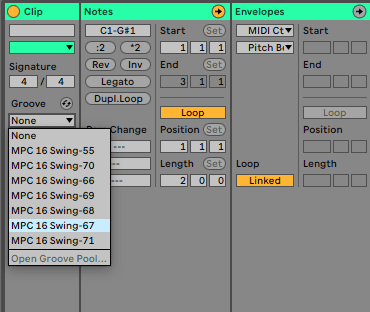In this instalment of Beat Dissected we’re going to create classic 90’s House with swing, groove and nostalgic throwback vibes.
Beat Dissected is a regular series in which we deconstruct drum patterns, showing you how to program them in any DAW. Just copy our grid in your own software to recreate the loop and to use the same one-shots you can download the sounds below that we used.
Here’s the beat we’re building today:
Audio PlayerIt don’t mean a thing if it ain’t got that swing
When programming drums like this, the focus is in achieving the swing that is so ubiquitous with 90’s house music. Of course, there are many different ways to achieve swing in your tracks and many different templates available. For this walkthrough, we’ll be using Ableton’s Core Library and the MPC swing templates that come bundled with the software. For advanced discussions on swing read these articles: Daw & Drum Machine Swing and Roger Linn on Swing, Groove and The Magic of the MPC’s Timing.
To use one of the Swing and Groove templates in Ableton you need to add it to your Groove Pool. This can be done by navigating to Packs in your browser, then use the Core Library dropdown, and head to Swing and Groove.
From here you can drag and drop a groove template into your Groove Pool. This groove will then appear in the groove dropdown found in Clip View, simply select the Groove and hit Commit, to ‘commit’ the groove settings to your audio/MIDI clip.
To enlarge any screenshot, just click to enlarge.
Spec
Tempo
122-127BPMSwing
55-60%Sounds
909Step 1
To begin with, we’ll work on the ‘straight’ elements in our loop. We load Kick 1 into a cell on the Drum Rack, and programme hits on the downbeats. We reduce the Sustain and control the length of the sample with the Decay, shortening the sample slightly for a tighter, punchier hit.
Audio Player

Step 2
Next we add some hi-hats to the offbeat. First up, we add Open Hat 1, softening the transient by backing off the Attack. Then we add Closed Hat 1, again programming hits in the offbeats, and once again softening the Attack slightly.
Audio Player

Step 3
Now to add a Clap/Snare combo. First, we add Clap 1, adding hits on the upbeats. We follow this with Snare 1, again adding hits on the upbeats but this time we back off the Attack on the snare and shorten the length of the sample slightly by taking off the Sustain and bringing down the Decay.
Audio Player


Step 4
Next we duplicate the Closed Hat 1 cell, and with this new version we back the Attack off even more, so there’s no transient at all. We programme 4 syncopated hits in each bar. We vary the velocity of each hit and also make some of the hits longer, so they have more release.
We then add Closed Hat 2, and program hits in conjunction with the previous hat hits, to accentuate them and add variety to the syncopation.
Audio Player


Step 5
Next we add Snare 2. Backing off the Attack to around a 1/4 of the way, we shorten the envelope again using the Sustain and Decay.
We programme syncopated hits, adding 1 in the first bar and 3 in the second to add some variety between each bar.
Next we program Chord 1. We’ve shortened the sample by bringing down the Sustain and Decay. Adding mostly syncopated hits we also include one hit in the offbeat, which provides extra rhythm and swing. We also apply a small amount of Reverb to the Chord to help it sit in the mix.
Now in Clip View, we navigate to the Groove dropdown and select the MPC 16 Swing-67 template we added into our Groove Pool earlier. Once selected, we hit Commit to add the swing to all our hits.
Audio Player


Step 6
Finally, we add some group processing by using Ableton’s Drum Buss plugin. We push the Drive up to 28%, the Crunch to 16% and the Transients to 0.05. We also take the Out down to -2.94dB to level compensate.
Audio PlayerWhile You’re Here…
If you like this article you might enjoy our book The Secrets of Dance Music Production. It is available from the Attack store!
New customer? Use code ATTACK10WELCOME at checkout for a 10% discount!






